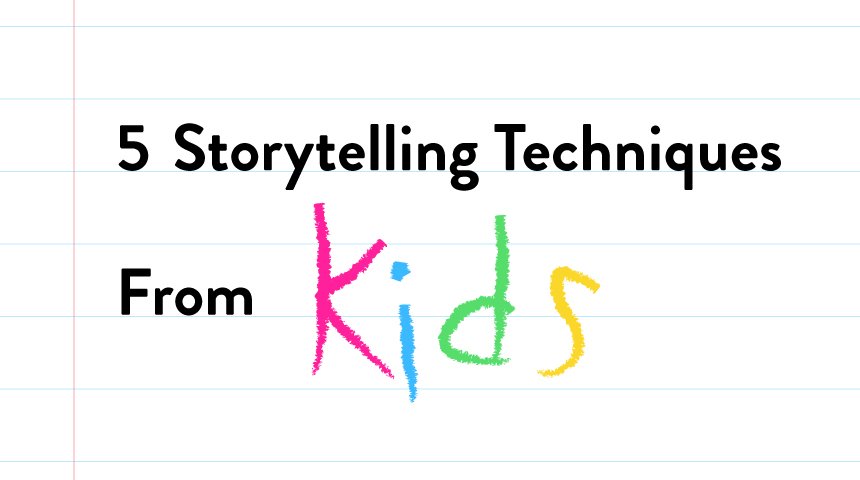Storytelling is one of the oldest forms of communication.
About 500,000 years ago, humans began to use words and language to name those things around us. It wasn’t long until we learned to order those words into elaborate stories to explain our actions, our experiences, and our world.
But if we want to be good storytellers, we don’t need to look back to early humans for the secrets. New humans, or children as some people like to call them, are apt and inspired storytellers who can teach us the essential elements of storytelling that often get overlooked.
If we want to get to the heart of what makes a good story, we need to start taking some tips from the pros — kids.
Here are five tips, straight from the playground, that will help you unlock your natural storytelling mojo.
1. Get excited
Kids have the uncanny ability to find fun and excitement anywhere. And that excitement is contagious for the simple reason that it is genuine. They are actually excited. They aren’t faking it.
So when it comes to your internal communications, are you excited about what you’re telling employees? Or are you faking it?
After all, if you aren’t engaged with the content, how can you expect employees to be?
Find a way to get excited about what you’re communicating and translate that enthusiasm. When communicating with genuine enthusiasm, that excitement is catching and engaging.
But how can you do this?
Find out in our next tip:
2. Learn how to show and tell
Do you remember show and tell as a kid?
You'd bring an object that was special to you to show to your class. You’d do your best to describe where it came from, what it did, and why you loved it.
The reason why these presentations were so engaging, both to the tiny-presenter and the tiny-audience, was because we got to see the object, interact with it, and were given context for its importance.
Imagine a room full of small children sitting around quietly, patiently listening to a presentation about an object they couldn’t interact with or see.
Yeah, neither can we.
How often in your communications do you show your readers what you mean, rather than just telling them?
Now we aren’t in grade school anymore, and we don’t do much show and tell in the corporate world, but the idea of showing people, and using visual or interactive media to communicate, is becoming more prevalent as technology advances.
Not only are images, videos, infographics, memes, etc., all fun ways to spice up your content, but they may also be the best ways to help people understand your communications.
According to the Social Science Research Network, 65% of people are visual learners. Studies have also shown that when we hear information we are only likely to remember 10% of it in the subsequent three days. But, if there is an image associated with that information, 65% of people will retain that information up to three days later.
It may come as no surprise, but images also blow text out of the water when it comes to engagement. When images are relevant, readers will actually spend more time looking at images than reading text. Studies have also shown that people pay closer attention to images that carry information, like memes.
But there is a caveat: these same eye-tracking studies show that stock photos, images of fake people, or purely decorative photos annoy people and will be ignored.
Why?
Because they lack authenticity. They aren’t genuine.
3. Be genuine
Kids say the darndest things. They have no filter, which makes a lot of what they say hilarious.
The thing is, they aren’t trying to be funny. They are funny because they are being honest. They are being themselves. It’s hilarious because it is so rare and refreshing.
And we always know when they’re lying. Crocodile tears fool no one and young children are notoriously bad liars.
Now we aren’t saying ditch your filter and say whatever pops into your head. But keep in mind that people can usually tell when you’re faking it. It’s pretty obvious when someone is pretending to care, even if it becomes the norm inside an organization.
So figure out how to care about the story you’re telling. Find a perspective or give the story context that matters, so you can genuinely express your sentiment.
Genuine expression will always land better than faking it. Emotionally honest writing and communication is the most effective way to engage people with your story or content.
4. Keep it simple
Kids communicate complex ideas and stories without knowing a whole lot of words.
Despite the simplicity of their storytelling, they can still manage to articulate some pretty intricate stories, what they mean, and why they’re important.
The bottom line is: You don’t need a huge vocabulary or to be an expert to clearly communicate an idea. Simple is always better.
Not only will simplifying your language and style make your writing clearer and easier to read, but it allows every member of your workforce to access the information they need.
Regardless of their reading level, you need all communications to be accessible. Using jargon or complicated corporate language and acronyms will only alienate your employees.
And when you’re responsible for communicating to an organization with employees all over the world, your messages may be translated. Keeping your language simple and your ideas clear allows your comms to be translated more easily and retain more meaning. It also makes your comms more accessible and enjoyable to those of your workforce whose first language isn’t English.
5. Keep asking why
Perhaps the most endearing (or infuriating, depending on your perspective) quality of children is their insatiable curiosity.
No one asks why more than a child.
“Why?” is one of their most useful tools for learning about the world.
As we get older, the “why” of the matter doesn’t become less important. We still want to know why, but we’re less inclined to badger each other by asking for more information or context.
Your employees want to know why you’re communicating what you’re communicating. They want to know why it matters. They want to know why the story is important. They want to understand the context.
If you don’t explain the why, readers won’t ask. They’ll just tune out.
When you are telling a story or writing a communication, it’s essential that you get to the heart of the issue by continuing to ask why it matters. If you can convey the “why,” people are more likely to remember and understand the relevance of the story. And then you can say with confidence that your message has been communicated and received.
You're a natural storyteller
Kids don't have to be taught about beginnings, middles, ends, plots, or characters to know how to tell a story. We all have an innate ability to create stories about the world around us.
But most of us stop practicing once we reach adulthood. A good communicator knows how to access this ability and use it to connect employees to the bigger picture.
If your storytelling muscle is out of shape, don't fret.
Check out our data storytelling guide and these 3 powerful ways to use storytelling in your internal comms to get some actionable advice—and measurable results.




